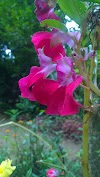ABOUT 'BENINCASA HISPIDA' PLANT
Benincasa hispida
FAMILY:- CUCURBITACEAE
BOTANICAL NAME:- Benincasa hispida
VERNACULAR NAMES :
SINHALA : Alupuhul, Puhul
TAMIL : Kalyanappushinikkay, Pusanikkai, Wattakkai, Sambal Pusanikkai
ENGLISH : Wax gourd, White gourd, Ash gourd
DESCRIPTION :
A large trailing or climbing plant with stout angular, hispid stems, tendrils 2-fid.
LEAVES:- 10-25 cm diameter, reniform-orbicular, cordate, more or less deeply 5lobed, hispid, beneath petioles 7.5-10 cm long without glands.
FLOWERS:- Large yellow monecious, all solitary without bracts.
FRUITS:- 30-45 cm long broadly cylindric, not ribbed, hairy, ultimately covered with a waxy bloom; seeds many,oblong, compressed and margined (Jayaweera, 1980)
DISTRIBUTION:
Benincasa hispida grows wild in Java and cultivated throughout India, Sri Lanka and other tropical countries (Tindall, 1993). In Sri Lanka it is mostly cultivated in the dry zone during the rainy season and elsewhere throughout the year.
EDIBLE PART : The fruit, seeds, young leaves and flower buds.
FOOD USE : The young and matured fruits are eaten as a vegetable. Grated inner portion is boiled with sugar to prepare sweets. Seeds are roasted and eaten. Young leaves and flower buds are eaten as green vegetables.
NUTRITIONAL AND THERAPEUTIC VALUE:
Moisture - 96.5 g,
Energy -10 kcal,
Proteins -0.4 g,
Fat -0.1 g,
Carbohydrates - 1.9 g
Calcium - 30 mg,
Phosphorus - 20 mg,
Iron - 0.8 mg,
Carotene - 0,
Thiamine - 60 meg,
Riboflavin - 10 meg,
Niacin 0.4 mg, C - 1 mg.
The fruit contains a fixed oil, starch,cucurbitine, resin, proteins, myosin and vitellin, sugar and Vitamin B and C. The fresh juice is a specific antidote for mercuric, ^ alcoholic and snake bite poisoning. It is used for insanity, epilepsy and other nervous diseases. The cortical portion of the fruit is given for diabetes. A decoctions of the leaves with rock salt is given for cholera. Decoction of the stem and fresh juice of the fruit are also antidotes for many vegetable poisons. In Indo-China, the leaves and seeds are given as a purgative (Jayaweera, 1980).
ENVIRONMENTAL RESPONSE:
Elevation below 500 m, with relatively high temperature and moderate rainfall is good for ash melon. The demand for water is very high during the early period of vegetation. Relatively low temperature and short daylength stimulate the development of female flowers.
CULTIVATION :
Propagation is by seeds. Five seeds are normally planted together, 2-4 cm deep on ridges, mounds or in prepared beds or holes. Alternatively, container-sown seedling may be transplanted when they are 10-15 cm high. The ideal time for sowing is at the beginning of the rains. Seed rate is 5-7 kg/ha. Spacing rows 20 cm apart with 60-100 cm between plants, ridges or mounds 75-90 cm apart each way. Irrigation- is required at regular intervals particularly during dry periods.
Fertilizer-NPK before sowing or planting.
Time of harvest - Leaves are ready to be picked in 35- 60 days, fruits 80-140 days from sowing or planting.
Harvesting - As soon as the plant vines are about 60 cm length, fruits before the seeds begin to ripen, and when the skin begins to harden.
Yeild - About 20 T/ha.
STORAGE:
Undamaged fruits are hung and kept around 6 months and more.








